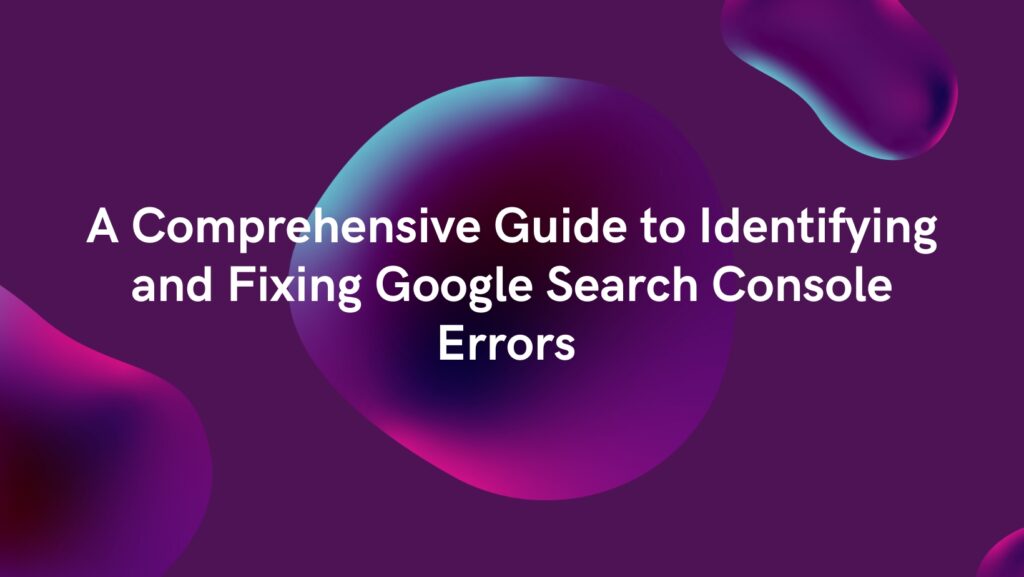Google Search Console Guide:
For webmasters, marketers, and SEO specialists, Google Search Console (GSC) is a must-have tool because it offers insightful information about how well a website performs and appears in Google search results. Dealing with Google Search Console errors, however, can be difficult. We will examine the most frequent GSC errors, their effects on your website, and the best ways to spot and correct them for a seamless website experience in this comprehensive guide.
Crawl errors
Crawl errors happen when Googlebot has trouble accessing your website or specific pages. The visibility of your website on search engine result pages (SERPs) may suffer as a result of these mistakes. Site-wide and URL-specific errors are the two types of crawl errors.
Site-wide Errors
Errors on the entire website prevent Google from crawling and indexing your content because they affect the entire website. Typical site-wide mistakes include:
DNS mistakes: When Googlebot is unable to connect to the server that is hosting your website, DNS mistakes happen. To resolve this problem, make sure your server is set up correctly, and if necessary, ask your hosting company for help. These errors happen when Googlebot is unable to access your website because of a server problem. Verify your server logs, and server capacity, and that your hosting company is not preventing Googlebot from accessing your website. If Googlebot is unable to access your robots.txt file, this error will appear. Verify the accessibility and syntax of your robots.txt file.
URL-specific ErrorsURL-specific errors are issues that affect individual pages on your website. Some common URL-specific errors include:
404 Not Found: When Googlebot tries to access a page that doesn’t exist, it encounters this error. Create an appropriate page for the URL, reroute the URL to an appropriate existing page, or delete the link to the inappropriate page to resolve this problem.
Soft 404: A soft 404 error occurs when a non-existent page instead of returning a “404 Not Found” status code, returns a “200 OK” status code. Either create a relevant page or implement a suitable 404 response to fix this.
Access Denied: This error happens when a page is password-protected or has a disallow directive in the robots.txt file, preventing Googlebot from accessing it. Update your robots.txt file or remove the password protection to fix this.
Errors in Index Coverage
Index coverage issues make it difficult for Google to properly index the content of your website. Index coverage mistakes that are frequent include:
Submitted URL Blocked by Robots.txt: This error happens when a URL entered in your sitemap is prohibited by a robots.txt disallow directive. Update your robots.txt file to permit Googlebot to crawl the blocked URL to resolve this.
Submitted URL Not Found (404): This problem arises when a submitted URL cannot be found, much like the 404 crawl error. Verify that the URL you submitted is valid and update your sitemap accordingly.
Duplicate Content: In order to avoid providing users with the same results repeatedly, Google may decide not to index pages with duplicate content. To identify the preferred version of a page, use canonical tags, and whenever possible, get rid of duplicate content.
Errors in Mobile Usability
Google gives mobile-friendly websites priority as the use of mobile devices for internet browsing increases. Errors in mobile usability have a negative impact on the user experience on mobile devices. Typical mistakes in mobile usability include:
Viewport Not Configured: To resolve this problem, make sure your website is responsive and that your HTML contains a viewport meta tag.
Wider than the Screen Content: Fix this by changing your website’s layout and design to fit mobile devices’ smaller screens.
Too Many Clickable Elements Together: A clickable element that is too close to another clickable element may be difficult for mobile users to interact with. Increase the distance between the buttons, links, and other interactive elements on your website to resolve this problem.
Structured Data Errors
Structured data aid Google in comprehending the content of your website and enhances the look of your search results with rich snippets. However, incorrectly formatted data can prevent Google from properly comprehending and displaying your content. Typical mistakes with structured data include:
Missing Required Properties: Ensure that all required properties for a specific schema type are included in your structured data markup.
Invalid Values: Verify that your structured data markup’s property values are provided in the appropriate format and follow the schema’s rules.
Unfinished Markup: Ensure that your structured data markup is complete and contains all elements required for the particular type of schema.
Use the Rich Results Test or Google’s Structured Data Testing Tool to find problems with your website’s code and correct them in order to fix structured data errors.
Security Issues
Google puts a high priority on user security and may highlight websites with security flaws. The functionality and search engine visibility of your website may suffer as a result of these problems. Several typical security problems include:
Hacked Content: If your website has been compromised and the compromised content is malicious, remove it and submit a review request to the GSC.
Malware: If your website has been flagged as having malware, find and remove the harmful code before asking the GSC to review it.
SSL Certificate Errors: Make sure your website has a current SSL certificate, and make sure your server is set up to use HTTPS.
It can be overwhelming to deal with Google Search Console errors, but fixing them is essential to making sure your website performs well in search results. You can enhance the accessibility, usability, and overall performance of your website by locating and resolving crawl errors, index coverage errors, mobile usability issues, structured data issues, and security problems. Stay proactive by regularly checking your Google Search Console and acting quickly when errors are found. This will guarantee a seamless website experience and keep your website prominent in Google search results.



